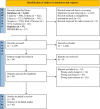Immunogenicity and safety of inactivated quadrivalent influenza vaccine compared with the trivalent vaccine for influenza infection: an overview of systematic reviews
- PMID: 37644401
- PMCID: PMC10463610
- DOI: 10.1186/s12879-023-08541-0
Immunogenicity and safety of inactivated quadrivalent influenza vaccine compared with the trivalent vaccine for influenza infection: an overview of systematic reviews
Abstract
Background: Influenza infection is a highly preventable transmissible viral disease associated with mild upper respiratory symptoms and more severe conditions such as lethal pneumonia. Studies have shown that a broader spectrum influenza vaccine could reduce influenza's burden of disease in low- and middle-income countries. A considerable number of systematic reviews reported that quadrivalent influenza vaccines are considered more effective compared to trivalent vaccines, hence, there is a need for an overview in order to synthesize the current evidence pertaining to the comparison between quadrivalent and trivalent inactivated influenza vaccines.
Objective: The aim was to summarize the evidence from systematic reviews that investigated the immunogenicity and safety of the Influenza's inactivated quadrivalent vaccine (QIV) compared to the trivalent vaccine (TIV), in the general population.
Methods: We searched articles up to December 2022 at: Web of Science, EMBASE, MEDLINE, Cochrane Library, and SCOPUS. The search strategy was conducted following the PICO model. We included systematic reviews comparing the primary outcomes of immunogenicity (seroprotection rate and seroconversion rate) and adverse events using risk ratios. The AMSTAR 2 and ROBIS were used for quality assessments, and GRADE was used for evidence certainty assessments.
Findings: We included five systematic reviews, totalling 47,740 participants. The Quadrivalent Inactivated Influenza Vaccine (QIV) exhibited enhanced immunogenicity in the context of B-lineage mismatch when compared to the Trivalent Inactivated Influenza Vaccine (TIV). While the safety profile of QIV was found to be comparable to that of TIV, the QIV showed a higher incidence of solicited local pain among children and adolescents, as well as an increased frequency of local adverse events within the adult population.
Conclusion: Our findings suggest that the QIV provides a superior immunogenicity response compared to the TIV in all age groups evaluated, especially when a lineage mismatch occurred. The safety of QIV was considered similar to the TIV, with no serious or systemic solicited or unsolicited adverse events; tough pain at the injection site was greater for QIV. We recommend caution owing to the high risk of bias in the selection process and no protocol registration.
Keywords: Efficacy; Flu; Immunogenicity; Vaccination.
© 2023. BioMed Central Ltd., part of Springer Nature.
Conflict of interest statement
Maria da Graça Salomão is a researcher at Instituto Butanta. The author states that Instituto Butanta has no role in the design and implementation of the study or in the data analysis and presentation of the results. All the other authors declare that they have no competing interests.
References
-
- Kawai S, Nanri S, Ban E, Inokuchi M, Tanaka T, Tokumura M, Kimura K, Sugaya N. Influenza vaccination of schoolchildren and influenza outbreaks in a school. Clin Infect Dis. 2011;53(2):130–6. - PubMed
-
- Omer I, Rosenberg A, Sefty H, Pando R, Mandelboim M, Mendelson E, Keinan-Boker L, Glatman-Freedman A. Lineage-matched versus mismatched influenza B vaccine effectiveness following seasons of marginal influenza B circulation. Vaccine. 2022;40(6):880–5. - PubMed
Publication types
MeSH terms
Substances
LinkOut - more resources
Full Text Sources
Medical


